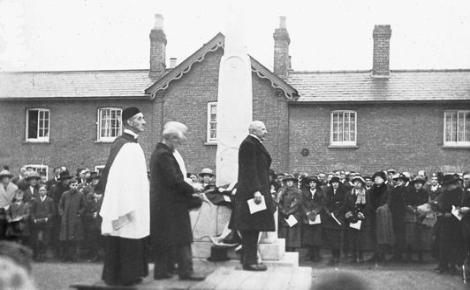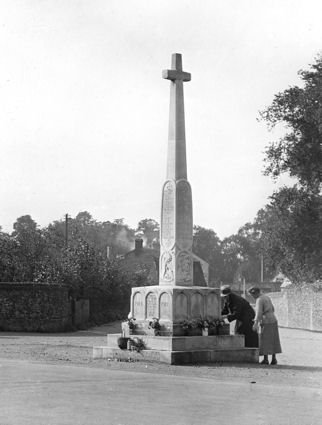Following his appointment as Head Teacher of the Church School in 1908, Percy Robinson built up an extensive knowledge of Trumpington’s history. One of his individual notes from the 1920s is about the War Memorial, reproduced below.

WAR MEMORIAL
At a meeting of the Parish Council held on _____ the subject of perpetuating the memory of the men of Trumpington who gave their lives in the Great War was discussed. It was decided to call a meeting of Parishioners to ascertain their desires, and a sub – committee of three, Messrs. C. Forbes, T. H. J. Porter, and P. R. Robinson, was appointed to arrange necessary details for the meeting.
The meeting was held on Thursday, 8th May, 1919, in the Village Hall. Mr. T. H. J. Porter was elected chairman. The meeting decided that a War Memorial should be erected, and appointed a committee to consider suggestions and report again to the Parishioners. The following suggestions were put forward:-
1. That a handsome tablet of some imperishable material be placed in the Church.
2. A memorial cross be placed in the New Churchyard.
3. A cross be erected on the Cross Hill.
4. A plain obelisk be erected on the Cross Hill.
5. A clock tower and shelter be erected on the Cross Hill.
6. A memorial be placed in a garden with tennis courts and other space for the furtherance of sport.
7. In combination with the visible memorial some scheme whereby assistance could be given to the disabled, or dependents of the fallen men should be assisted educationally.
A long interval elapsed before the next meeting, which was held on 24th June, 1920, but it was explained by the chairman that the reason was because the committee was so anxious to obtain something worthy of the men and the village.
Two models, one of a cross and one an obelisk, were on view, also the drawing for a plaque.
The meeting decided in favour of the cross and that it should be erected on the Cross Hill. The committee was instructed to raise the necessary funds and proceed with the memorial.
The next meeting was held on 15th November, 1921, when the proposed programme for the Dedication and Unveiling was approved.
The final meeting was held on 24th October, 1923, when the balance sheet for the Memorial was placed before the parishioners and adopted. The Balance Sheet is as follows:-
The accounts were audited 1st August, 1922 and showed a balance of £19 .. 18 .. 3 , but interest raised the amount to £20 .. 13 .. 8 on 30th June, 1923.
The meeting resolved “That the Trumpington Parish Council be asked to accept on behalf of the Parishioners, the Trumpington War Memorial as a sacred trust, with the following conditions:
(a) To accept the balance of the War Memorial Account in hand, viz. £20 .. 13 .. 8, which shall be deposited at a Bank (Lloyd’s) as a separate account in the name of the Trumpington Parish Council War Memorial Account.
(b) The money to be utilized solely to preserve the Memorial.
(c) A yearly statement of accounts to be submitted to the Parish Meeting at the same time that the Charity Accounts are presented.
(d) No alterations or additions to be made to the existing Memorial without the consent of a Parish Meeting.”
Votes of thanks were passed to the committee and officers for the work so generously undertaken.
The outstanding and dominating feature that pervaded the whole of the meetings was the desire to obtain something that was worthy of the men and an ornament to the village.
The Parish Council accepted the charge of the Memorial and balance on the above terms at a meeting held on [24 October 1923].
Eight hundred copies of the Ceremony of Unveiling and Dedication were printed.
Of the total subscriptions the Pemberton Family contributed over £200.
TRUMPINGTON WAR MEMORIAL

The Memorial, which is of Portland stone, consists of a shaft fourteen feet six inches high, surmounted by a cross with a monogram K.R. (Greek initial letters of Christos) in the middle, standing upon a base four feet square, on a flight of three steps. The whole monument is nineteen feet in height.
The names are inscribed in Roman letters in panels on the four sides of the shaft, this position being chosen as the most honourable, for the monument is primarily a cross (the emblem of sacrifice) , with the base a subordinate feature, merely for the purpose of supporting the cross. The names appear in the following order:-
E. PANEL.
William Brown
Hugh Chaplin
Charles Chaplin
Herbert Chapman
George Day
Robert Flack
William Flack
Charles Foster
George Freestone
N. PANEL.
Edward Gray
Maurice Gray
Herbert Green
William Harrod
Arthur Haslop
Charles Hicks
William Huckle
William Iles
Christopher Gowland
W. PANEL.
Bertie King
Harry Matthews
Charles Metcalfe
Frank Mynott
Frank Peters
Sidney Peters
Arthur Scates
Anthony Isaacson
Francis Pemberton
S. PANEL.
Harold Scott
Arthur Smith
Ernest Stearn
Raymond Trigg
Albert Wilson
James Wilson
Robert Wilson
William Wilson
John Whittamore
Below the name panels are four carved panels, these representing St. Mary and St. Michael (the patron saints of the parish) , St. George (the patron saint of England), and in the fourth the figure of a soldier. These carved panels have been executed with a view to Symbolism rather than Naturalism.
St. Michael slaying the Dragon is represented on the East side. In this case the Dragon is the Devil in the form of a monster, having the body of a woman and the tail of a serpent. This combination suggests that though the devil always appears in the most attractive form, he never wears a complete disguise. Various vices are indicated, especially unbelief (non est Deus); deceit (the serpent); avarice (the breasts with mouths instead of nipples, for he devours and gives no nourishment). The flames behind show his chosen element. St. Michael, a winged figure with flowing hair, whose name in Hebrew signifies the question, “Who is like unto God?” (quis ut Deus) is thrusting the sword of Truth into the mouth of unbelief.
On the North side is depicted St. George slaying the Dragon who would destroy Religion, i.e. St. George the Christian Champion. The hand of God appears in the sky in the attitude of blessing. The woman represents the Church, which is tied to the tree representing the earth.
On the West side appears St. Mary with the babe in the cradle. The Lily on the shelf is the emblem of Purity.
On the South side is the figure of a soldier, very tired and heavily burdened, walking towards the setting sun, i.e. going West. The arm almost touching the ground is typical of his worn out strength, whilst the fingers, being straight, convey the idea of discipline and the tired mind endeavouring to overcome the physical wreck. The broken and splintered tree stumps show the havoc of warfare.
The base has three panels on each side. On the East side the inscription is as follows:-
MEN OF TRUMPINGTON WHO
1914 GAVE THEIR LIVES IN THE 1918
GREAT WAR.
In the centre panel on the West side are the words :-
FOR LIBERTY AND JUSTICE.
Scanned from Percy Robinson’s original typescript by Howard Slatter.
See the separate page for additional information about the War Memorial.